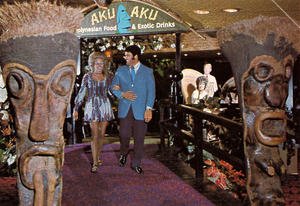Eli Hedley - The Original Beachcomber
Born:
October 31, 1903;
Vernon TX
Died:
September 12, 1981;
Orange County, CA
Known as “the original Beachcomber”, Eli Hedley was the populizar of what is known as the “beachcomber” aesthetic that has long been so inextricably entwined with southern California.
An impoverished grocer from Oklahoma, Hedley moved to California with his wife and four children during the Great Depression.
There, they settled south of Los Angleles in San Pedro at White Point cove on Royal Palms Beach.
It was here that he and his family built their own house by the sea—themselves—out of drift wood, decorating it with nearby shells, glass and nautical equipment.
 Soon after, Hedely began selling his seaborne housewares to department stores and creating furniture with the flotsam that washed up on his shore .
Soon after, Hedely began selling his seaborne housewares to department stores and creating furniture with the flotsam that washed up on his shore .
 (One of his four daughters, Bungy Hedley, captured this story in 1947 with How Daddy Became a Beachcomber.)
(One of his four daughters, Bungy Hedley, captured this story in 1947 with How Daddy Became a Beachcomber.)
Others soon began taking notice of his unusual aesthetic, and before long he was decorating entire hotels, restaurants, apartments and celebrity homes.
 He created the massive maoi for the Stardust’s Aku Aku in Las Vegas, decorated Pago Pago, Trader Dick’s and Harvey’s, and was even hired by Walt Disney to decorate Adventureland, where he later sold hand-carved tikis from his Island Trade Store .
He created the massive maoi for the Stardust’s Aku Aku in Las Vegas, decorated Pago Pago, Trader Dick’s and Harvey’s, and was even hired by Walt Disney to decorate Adventureland, where he later sold hand-carved tikis from his Island Trade Store .
In the late 70s, Hedley finally retired to the Islander apartments in Santa Ana (decorated by himself, of course) before passing away in 1981.
Thankfully, his creative genes were passed on to his grandson, Bamboo Ben, who also makes a wide variety of island furniture and accessories, and has done décor for the Konai Club in Oakland, the Kon-Tiki in Tuscon, Forbidden Island, the Tonga Lei Room and Tiki No.
 On August 27, 2006, Bamboo Ben and Hedley’s three surviving daughters held a historical booksigning in Huntington Beach for readers of How Daddy Became a Beachcomber and the Eli Hedley Beachcomber 1943 Catalog Reprint.
On August 27, 2006, Bamboo Ben and Hedley’s three surviving daughters held a historical booksigning in Huntington Beach for readers of How Daddy Became a Beachcomber and the Eli Hedley Beachcomber 1943 Catalog Reprint.
With regards to Hedley's beach cove residence, all that remains of it is the foundation. A small plaque detailing its history stands nearby.
This could be just as well, since all one must really do to fathom Hedley’s extroardinary influence in southern California is to remember the inscription on architect Sir Christopher Wren’s plain stone plaque :
“Reader, if you seek his influence—look around you.”

